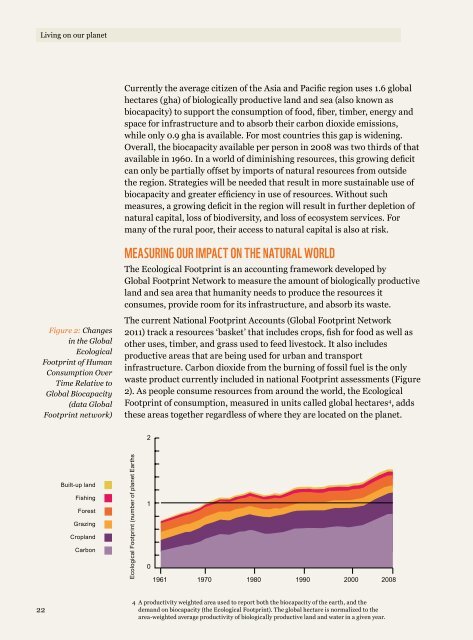Download the pdf - Global Footprint Network
Download the pdf - Global Footprint Network
Download the pdf - Global Footprint Network
You also want an ePaper? Increase the reach of your titles
YUMPU automatically turns print PDFs into web optimized ePapers that Google loves.
22 22<br />
Living on our planet<br />
Figure 2: Changes<br />
in <strong>the</strong> <strong>Global</strong><br />
Ecological<br />
<strong>Footprint</strong> of Human<br />
Consumption Over<br />
Time Relative to<br />
<strong>Global</strong> Biocapacity<br />
(data <strong>Global</strong><br />
<strong>Footprint</strong> network)<br />
2000 2008<br />
Built-up land<br />
Fishing<br />
Forest<br />
Grazing<br />
Cropland<br />
Carbon<br />
Currently <strong>the</strong> average citizen of <strong>the</strong> Asia and Pacific region uses 1.6 global<br />
hectares (gha) of biologically productive land and sea (also known as<br />
biocapacity) to support <strong>the</strong> consumption of food, fiber, timber, energy and<br />
space for infrastructure and to absorb <strong>the</strong>ir carbon dioxide emissions,<br />
while only 0.9 gha is available. For most countries this gap is widening.<br />
Overall, <strong>the</strong> biocapacity available per person in 2008 was two thirds of that<br />
available in 1960. In a world of diminishing resources, this growing deficit<br />
can only be partially offset by imports of natural resources from outside<br />
<strong>the</strong> region. Strategies will be needed that result in more sustainable use of<br />
biocapacity and greater efficiency in use of resources. Without such<br />
measures, a growing deficit in <strong>the</strong> region will result in fur<strong>the</strong>r depletion of<br />
natural capital, loss of biodiversity, and loss of ecosystem services. For<br />
many of <strong>the</strong> rural poor, <strong>the</strong>ir access to natural capital is also at risk.<br />
MeAsuRIng ouR IMPACt on <strong>the</strong> nAtuRAL WoRLD<br />
The Ecological <strong>Footprint</strong> is an accounting framework developed by<br />
<strong>Global</strong> <strong>Footprint</strong> <strong>Network</strong> to measure <strong>the</strong> amount of biologically productive<br />
land and sea area that humanity needs to produce <strong>the</strong> resources it<br />
consumes, provide room for its infrastructure, and absorb its waste.<br />
The current National <strong>Footprint</strong> Accounts (<strong>Global</strong> <strong>Footprint</strong> <strong>Network</strong><br />
2011) track a resources ‘basket’ that includes crops, fish for food as well as<br />
o<strong>the</strong>r uses, timber, and grass used to feed livestock. It also includes<br />
productive areas that are being used for urban and transport<br />
infrastructure. Carbon dioxide from <strong>the</strong> burning of fossil fuel is <strong>the</strong> only<br />
waste product currently included in national <strong>Footprint</strong> assessments (Figure<br />
2). As people consume resources from around <strong>the</strong> world, <strong>the</strong> Ecological<br />
<strong>Footprint</strong> of consumption, measured in units called global hectares4 , adds<br />
<strong>the</strong>se areas toge<strong>the</strong>r regardless of where <strong>the</strong>y are located on <strong>the</strong> planet.<br />
Ecological <strong>Footprint</strong> (number of planet Earths<br />
Ecological <strong>Footprint</strong> (number of planet Earths)<br />
2<br />
Built-up land<br />
Fishing<br />
Forest<br />
Grazing<br />
Cropland<br />
Carbon<br />
1<br />
0<br />
1961<br />
1970 1980 1990 2000 2008<br />
4 A productivity weighted area used to report both <strong>the</strong> biocapacity of <strong>the</strong> earth, and <strong>the</strong><br />
demand on biocapacity (<strong>the</strong> Ecological <strong>Footprint</strong>). The global hectare is normalized to <strong>the</strong><br />
area-weighted average productivity of biologically productive land and water in a given year.<br />
Built-up land<br />
Fishing<br />
Forest<br />
Grazing<br />
Cropland<br />
Carbon

















